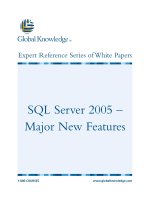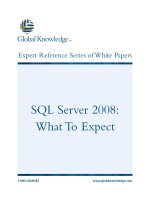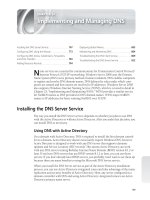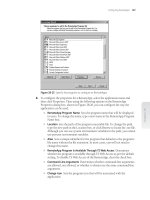Tài liệu SQL Server 2008: What To Expect pptx
Bạn đang xem bản rút gọn của tài liệu. Xem và tải ngay bản đầy đủ của tài liệu tại đây (488.66 KB, 8 trang )
SQL Server 2008:
What To Expect
1-800-COURSES
www.globalknowledge.com
Expert Reference Series of White Papers
Introduction
Are you ready for Microsoft SQL Server 2008? The truth is, many of us are still coming to grips with the great
new features of SQL Server 2005 so, when I ask this question to other database professionals, the response is
usually a polite answer, something of the order: “We may wait for the first service pack….” SQL Server 2005,
being a five-year release, included many architecture changes across the board and famously had so many
new features that, in order to fit them all on one PowerPoint slide, Microsoft had to use a 10-point font! Well,
in the words of David Campbell,
General Manager of SQL Server at Microsoft, the SQL Server 2008 release
,
nicknamed “Katmai,” is a “14-point font” release! The saving grace is that with this release, the new features
build on the existing architecture of SQL Server 2005, so Katmai is largely an evolutionary release as opposed
to a revolutionary one, allowing us to apply our existing skills while learning the new features. In this white
paper, we’ll explore some of these impressive new features so you can start planning your future upgrade
strategy
.
Figure 1. SSQL Server 2008 New Features
Brian D. Egler, Global Knowledge Course Director, MCITP-DBA, MCSE,
MCT 2008,
SQL Server 2008:What To Expect
Copyright ©2008 Global Knowledge T
raining LLC. All rights reserved.
Page 2
G
lobal Knowledge is the worldwide leader in IT and business training, delivering hands-on education via train-
ing facilities, private facilities, and the Internet, enabling our customers to choose when, where, and how they
want to receive training programs and learning services. To this end, we delivered SQL Server 2005 “early
adopter” training during the “Yukon” Beta in 2005, and this enabled us to deliver “just-in-time” training on
the actual day of release, using the officially released product in our Training Centers on Nov 7th 2005. This
same strategy will apply to the release of SQL Server 2008. Keep an eye on the Global Knowledge web site for
details at .
Your Data Any Place, Any Time
The Microsoft Data Platform Vision is summed up by the phrase: “Your Data Any Place, Any Time.” Within this
vision, four underlying themes categorize the Microsoft SQL Server 2008 release:
• Enterprise Data Platform
• Beyond Relational
• Dynamic Development
• P
ervasive Insight
In this white paper, we will be exploring just some of the new features under each theme to give you a feel for
the capabilities of the upcoming release. Other features, while too numerous to describe here, are documented
on the Microsoft web site at HYPERLINK " />.microsoft.com/sql. You
can also download a pre-release version of the softw
are or “CTP” (Community Technology Preview) from the
same location.
Enterprise Data Platform
SQL Server 2008 adds some significant functionality at the Enterprise Data Platform level, for instance, to
assist in multi-server configuration and control through the Declarative Management Framework (DMF), extra
security through
Transparent Data Encryption,
and instant hardware upgrade support through the
“Hot Add
CPU”
feature.
Declarative Management Framework (DMF)
The introduction of the DMF is a powerful new feature of SQL Server 2008. Now SQL Server data base admin-
istrators (DB
As) can define configuration policies against multiple servers, databases, tables, and indexes
enabling enforcement and consistency of database objects across multiple servers, if necessary, using configu-
ration servers and server groups. Policies can be enabled to either “prevent” or “log” object properties that
are
“out-of-compliance
.
”
A simple example may be to enforce naming conventions of stored procedures within
a database. You can choose whether to prevent out-of-compliance objects (in which case the CREATE PROCE-
DURE statement will fail) or just to log the non-compliance that can be reviewed in a report.
Another example may be to prevent SQL Mail from being configured on a group of SQL Servers. Again, you can
enable the policy to prevent or log the out-of-compliance objects
.
All policies can be easily defined using SQL
Server Management Studio. Individual policies can be grouped into categories and applied to targets (e.g.,
servers, databases, tables, indexes) or target hierarchies (e.g., all tables in a particular schema or all databases
on a server). This enterprise feature will greatly simplify multi-server administration and standards management.
Copyright ©2008 Global Knowledge T
raining LLC. All rights reserved.
Page 3
Figure 2. Declarative Management Framework Policy History Transparent Data Encryption
Transparent Date Encryption
In SQL Server 2005,
data encryption was introduced natively into the Database Engine. This allowed us for the
first time to encrypt individual sensitive columns in SQL Server without the use of third-party products. This
would protect sensitive columns of data should physical security be compromised such as an actual disk drive
or backup tape falling into the wrong hands. However, the implementation required application code changes
using functions such as EncryptByKey and DecryptByKey to encrypt and decrypt columns explicitly. Now in SQL
Server 2008,
Transparent Data Encryption allows a DBA to encrypt an entire database without the need for any
application code changes. All data pages within a database will be encrypted and decrypted automatically
using a Database master key and associated certificate whenever data is physically read from or written to
disk. In this way, if the disk drive or subsequent backup is compromised, the underlying physical data is always
Copyright ©2008 Global Knowledge T
raining LLC. All rights reserved.
Page 4
Figure 3. Transparent Encription
e
ncrypted. Although the encryption and decryption operations are scheduled on background threads by SQL
Server, it should be noted that, as with all encryption strategies, extra memory, and CPU power should be pro-
vided to deal with the extra processing cycles inherent in a secure solution.
Hot Add CPU
Following the “Hot Add Memory” of SQL Server 2005, now we can scale-up a server with extra CPU power
without having to bring down any services or applications. Again, Microsoft is delivering Enterprise-level sup-
port for 24x7 installations that are becoming more and more prevalent in the industry.
Beyond Relational
The Katmai release moves forward towards the future by supporting more than just relational data types as
we prepare for more advanced applications dealing with complex data types. Examples of support in the new
release are features such as Spatial Data and Virtual Earth Integration to support new mapping applications
and Filestream Data to allow database and file system integration.
Spatial Data and Virtual Earth Integration
Mapping applications are becoming more popular with
the advent of Google Earth, Virtual Earth, and the wide
use of GPS (Global P
ositioning Systems). To support
this, SQL Server 2008 has introduced Spatial data types.
The new geometry data type supports planar or “flat-
earth” data and conforms to the Open Geospatial
Consortium (OGC) specifications. The new geography
data type stores ellipsoidal or “round-earth” data, such
as GPS latitude and longitude coordinates. Using these
data types, applications can determine directions and
timings of travel between multiple points or determine
if a location or
“point”
is within a particular area or
“polygon.” These data types can also be used even if maps are not explicitly required in an application, as is
the case with distance/time analysis or text based directions. Integration with Microsoft’s Virtual Earth applica-
tion is also supported within this release.
Filestream Data
In previous releases there was always the debate as to whether to store unstructured binary large object
(BLOB) data, such as images, documents, audio, and video, inside the database or outside on the file system.
The problem with storing BLOB data outside of the database was that your data would be exposed in terms of
the lack of transaction processing and synchronized recovery
.
T
he adv
antage would be based on limiting the
size of the actual database
.
Now
,
in Katmai, you have a viable choice with the introduction of the Filestream
storage option so you no longer have to make compromises. This option allows the storage of SQL Server
BLOB data externally on the NTFS file system with synchronized, durable transaction processing and full recov-
ery options. The varbinary(max) data type is used in conjunction with the Filestream storage attribute on a col-
umn and although normal varbinary(max) columns are limited to 2GB of storage, no such limitation is
enforced on F
ilestream data columns
.
You are, therefore, only limited by your hardware in terms of storage. On
the performance side
,
Filestream uses the Windows system cache for caching file data so that the SQL Server
buffer pool is not used. Therefore, this memory is available for normal query processing.
Copyright ©2008 Global Knowledge T
raining LLC. All rights reserved.
Page 5
Figure 4. Spatial Data: Points and Polygons
Figure 5. Filestream Data
Dynamic Development
Katmai now supports developers through an Entity Framework allowing developers to program data requests
using the Microsoft Language Integrated Query (LINQ).
Further support for developers includes built-in Change
Tracking, Large Object User Defined Types (LOB UDTs) and the new Date/Time data types.
Microsoft Language Integrated Query (LINQ)
SQL Server 2008 now supports an Entity Data Model programming model through the latest version of
ADO.NET allowing developers to request data at a higher level of abstraction with the .NET languages instead
of SQL,
using the new Microsoft Language Integrated Query (LINQ).
LINQ is a unified programming model that
allows the implementation of any kind of data access, regardless of the underlying data structure. In this way,
developers can be more productive by having a common data access language by using CLR objects managed
by ADO.NET.
Change Tracking
Many applications require the tracking of changing data that in the past was typically implemented through a
series of Triggers and Timestamp columns. Now in SQL Server 2008, Change Tracking can be enabled automati-
cally at the Database and
T
able level, leaving SQL Server to track changes efficiently through internal system
tables without the need for coding Triggers or defining extra columns. Using Change Tracking functions such as
CHANGETABLE, allow an application to determine changes at the row or column level and to detect change
conflicts using a 2-w
ay synchronization model,
if necessary
.
Copyright ©2008 Global Knowledge T
raining LLC. All rights reserved.
Page 6
Figure 6: Change Tracking: Database Properties
Figure 7: Change Tracking Table Properties
Large Object User Defined Types (LOB UDTs)
In previous releases of SQL Server, User Defined Types were limited to 8000 bytes in size. That limitation has
been removed for SQL Server 2008,
enabling LOB UDTs.
New Date/Time Data types
Date/Time conversion and compatibility have always been major integration issues between database manage-
ment systems and now
, after many customer requests over the years, Microsoft has provided separate date
and time data types in order to assist with integration, in addition to the established datetime data type.
Pervasive Insight
Many improvements have been made in SQL Server 2008 with regard to the Microsoft Business Intelligence
solution, including scalability and performance enhancements to Analysis Services, Integration Services and
Reporting Services. New Data Visualization features have been introduced within Reporting Services, IIS
Agnostic Report Deployment is av
ailable and a new Report Designer has been developed to mak
e report
development easier and more flexible.
Data Visualization
Microsoft, having already acquired the popular ProClarity tools and rolled the products into PerformancePoint
Server 2007, has also acquired the Dundas visualization tools to assist with the development of powerful,
attractive reports through dashboard style controls
. Improvements within Report Services include such features
as chart scale-breaks and the new Tablix data region that combines the Table and Matrix data region objects
for further flexibility
.
Copyright ©2008 Global Knowledge T
raining LLC. All rights reserved.
Page 7
IIS Agnostic Report Deployment
SQL Server 2005 Reporting Services was reliant on the ASP.NET / IIS architecture, which forced the use of these
products for Web Services. The Reporting Services applications have been re-written so that other Web Services
products can be used as an alternative to IIS, providing security, performance and scalability choices.
New Report Designer
The Report Designer tool has been re-designed to add more flexibility to the development of reports within
Reporting Services. Now included is an Office 2007 look-and-feel, the addition of the new Dundas visualization
controls such as maps and gauges, and other features such as design-time Zoom.
Figure 8: New Report Designer
Conclusion
Microsoft SQL Server 2008 has many great new features that will allow you to develop higher performing,
more scalable next-generation applications using more than just relational data. Although this release will be
a little early for many customers, the fact that the features are largely incremental in nature should reassure
users that Microsoft is building on the established foundation of SQL Server 2005. Using the same architecture
and management tools
, customers will be able to smoothly upgrade their systems and skills, based on the
need for the new features and according to their own schedule.
Learn More
Learn more about how you can improve productivity, enhance efficiency, and sharpen your competitive edge.
For more information or to register, visit www.globalknowledge.com or call 1-800-COURSES to speak with a
sales representative.
Our courses and enhanced,
hands-on labs offer practical skills and tips that you can immediately put to use.
Our expert instructors draw upon their experiences to help you understand key concepts and how to apply
them to your specific work situation. Choose from our more than 700 courses, delivered through Classrooms,
e-Learning, and On-site sessions, to meet your IT and management training needs.
About the Author
Brian Egler is a Global Knowledge instructor and Course Director specializing in Microsoft SQL Server technolo-
gies. He currently resides in Holly Springs, North Carolina.
Copyright ©2008 Global Knowledge T
raining LLC. All rights reserved.
Page 8









